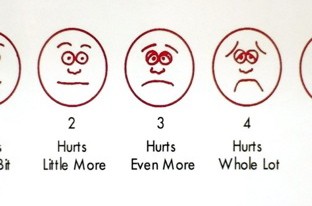Pain by number

The first time I saw an orthopedist about my bum hip, the nurse pointed to a row of smiley faces on the wall—six of them, with numbers and short phrases underneath. "What number is your pain?" she asked, waiting as I scrutinized the scale. Face One looked like a toddler on a swing ("Doesn't hurt at all"), but Face Two had lost her innocence ("Hurts a little"). Face Four looked as if she had a toothache ("Hurts even more"), while Face Five's smile had turned upside down ("Hurts a whole lot"). Face Six had tears running down her face ("Hurts all the time"). She looked as if a horse was standing on her foot.
This was not much to go on—the smiley face equivalent of a Rorschach test—but I did the best I could. My hip hurt all the time, thanks to a mild case of dysplasia I had hiked, biked and run with all my life. Now the cartilage was gone so that even sleeping hurt. I looked at the scale again. I definitely was not on the smiling end of the scale.
Read our latest issue or browse back issues.
The nurse glanced at her watch, twirling her pen between her fingers.
"Five, I guess," I said. "Sometimes six, but mostly five." She recorded my answer, asked a few more questions and took me to the X-ray room.
Twenty minutes later the doctor snapped my films onto the light board, tapped the bald head of my right femur and said, "It's not a matter of whether you have surgery but when—and trust me, you'll know when." While this was not happy news, it made me feel better about the smiley face test. At least the pain was real.
Less than a year later, I woke up in a hospital room with a new hip. Three times every day, the nurse pointed to the smiley face scale on the wall at the foot of my bed and asked, "What number is your pain?" Well, let me see. I have an eight-inch incision in my leg, the head of my femur has been sawed off, and a metal spike has been hammered into the hollow of the bone.
"Five," I said every time. "Six when the physical therapist is here, but mostly five." This might have been my answer even if I had not been allergic to the pain medicine prescribed for me, but since I was getting by on Extra Strength Tylenol I felt completely justified. If six was as high as the scale went, then six was what I wanted.
Within the week I was back home with the physical therapist assigned to help me to my feet. "What level is your pain?" she asked after she watched me stand and walk. By then I was an expert. "Three when I'm sitting," I said. "Four when I walk." She recorded my answer and gave me a folder with a free digital thermometer on one side and an inch of required reading on the other.
That was how I found the "Comparative Pain Scale Assessment Tool," an adult version of the smiley face scale with more detail to it. The highest level of pain—the one I had claimed in the hospital—was accompanied by this description: "more than any one human can live with; pain so intense you will go unconscious shortly; comparable to having your hand or leg crushed." The level right below that one said, "You would rather be dead than suffer like this; suicide is frequent since there is no more joy in life; comparable to throat cancer pain."
No one had to ask me to surrender the gold medal for pain. I handed it right over, feeling like someone who had demanded a body cast for a bee sting. How could I have known? I had never given birth, had cancer, or so much as broken a bone before hip surgery. My pain was a six for me, but how did it compare to the six of a soldier returning from Iraq with a missing limb or someone living with lupus? What is the pain level of a kid with appendicitis in a refugee camp or a battered woman with broken ribs?
I can only imagine. Pain is so attention-getting that it can put you on a planet all by yourself, where your face is the only face you see above the number that best describes your hurt. At the same time, pain is so human that it can put you in community with everyone else camped out around your number—all of you there for different reasons, but none of you there all by yourself.
In my case, pain was what moved me from point A to point B. It also moved me further down the scale, where I have landed at level three: "mild severity; pain may not be so strong that you cannot get used to it; physical therapy may help." While I aspire to level two ("You can function normally"), level one is of no interest to me ("No pain").
Who would I have to talk to there?






